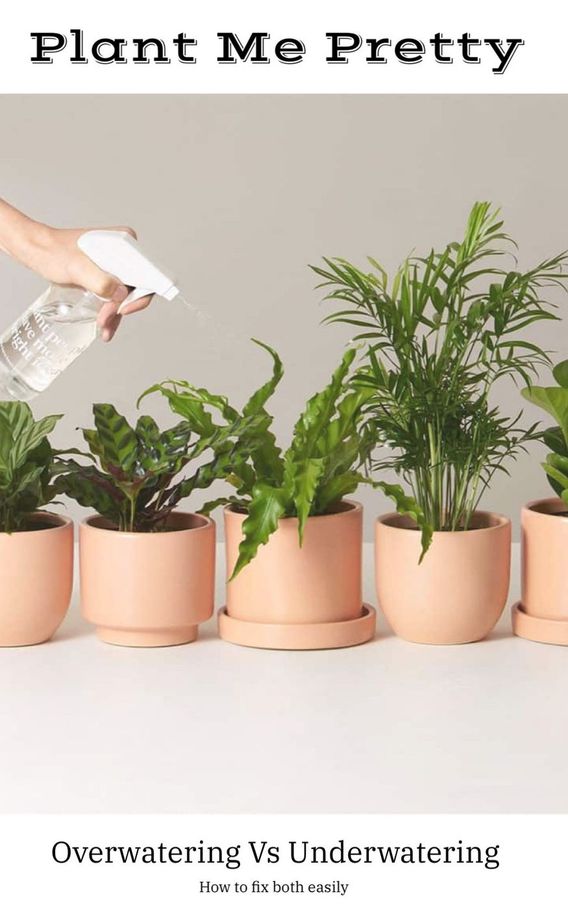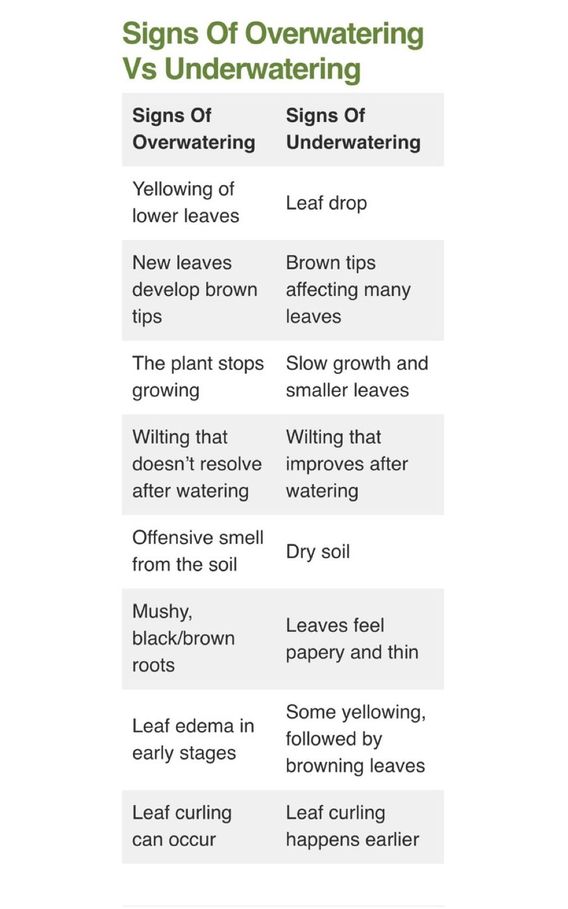
Overwatering Vs Underwatering
Overwatering is one of the most common houseplant problems but it can be difficult to tell the difference between an overwatered and underwatered plant. Knowing whether you are overwatering vs underwatering is essential if you want to keep your houseplants thriving. This article is going to explain how to easily tell the difference between the two and show you how to fix both.
Underwatering plants causes dry leaves, brown tips, leaf drop, wilting, and leaf curling. The soil will feel dry, but the plant will improve after watering. Overwatering causes yellowing leaves, brown tips, wilting despite wet soil, and also symptoms of underwatering if root rot has started.
This article will help you work out if your plant has been overwatered or underwatered, as well as explaining how to prevent both. I’ll explain why both are bad for houseplants, how to fix a plant that is struggling and share my favorite houseplants that can tolerate being over or underwatered.
Words by: SMARTGARDEN

What Is Wrong With My Plant? – Overwatering Vs Underwatering
If your plant isn’t happy, but you’re not sure whether it has been overwatered or underwatered, the most important thing to do first is feel the soil. An underwatered plant will always have dry soil. Underwatering is caused by complete water deficiency.
If your plant only has symptoms of underwatering, as outlined above, and the soil feels dry, you should water your plant and watch how it responds over the next 12-24 hours. An underwatered plant will respond quickly by recovering from wilting and looking much healthier.
If the plant has symptoms of both overwatering and underwatering, it is more likely to be overwatered. The damage from overwatering is caused by prolonged wet conditions, but the damage will still be present long after the soil dries out.
Rather than attempting to water your plant to see how it responds, you should carefully examine the conditions your plant has been growing in to see if you can work out for sure what the problem is.
The next section will walk you through exactly what to do, and I’m confident you will be able to correctly diagnose your plant and take the correct actions to try to fix it.
Words by: SMARTGARDEN
How Do You Tell If You Are Overwatering A Plant?
Unhealthy roots are unable to provide nutrients to the leaves, causing them to start to turn yellow. The initial abundance of water can cause blistering and edema of the leaves, but this soon gives way to water deficiency as the roots start to struggle and fail to deliver water and nutrients to the plant. Leaf tips, particularly of young leaves are most susceptible to drought and turn brown first.
Other leaves become dehydrated, papery and thin. As the leaves are responsible for a considerable amount of water loss under normal conditions, many plants start to curl their leaves, or shed them in an attempt to conserve water.
How To Prevent Overwatering
There are a number of simple but important ways to avoid overwatering your plants;
• Ensure good lighting – Plants grow much quicker and use available water in the soil faster when in good lighting. Even “low light” plants do better in bright conditions.
• Use well-draining soil – Add inorganic material to your potting soil, such as perlite, leca, gravel, or pumice to aid drainage and aeration. Water should soak into the soil immediately when watering.
• Avoid cool temperatures – Evaporation and plant growth are increased in warmer temperatures, increasing water use.
• Use pots that are just big enough – Large pots with more soil will take longer to dry out after watering. Putting your plants in a snug pot makes sure they will use all the available water in the soil reasonably quickly.
• Choose pots with plenty of drainage holes – Make sure the drainage holes are right at the bottom of the pot. Make more drainage holes if needed.
• Always check before watering – Check soil dampness, pot weight, and for signs of water stress before watering. Follow these tips to make sure you only water your plants when needed.
• Consider using porous pots – Terracotta pots are porous and will lose water through their walls, reducing the time it takes soil to dry. Read more about pot choices for houseplants here.
Words by: SMARTGARDEN
How To Fix Overwatering
The most important thing is to identify the early signs and make some changes to the conditions your plant is growing in, as outlined above.
If your plant is struggling with symptoms of overwatering, or you think your plant has root rot, you’ll need to take more significant steps to fix your plant. Just follow these steps to get your plant back on track;
• Gently slide your plant from the pot.
• Inspect the roots carefully. Rotten roots will be black/brown, fragile, mushy, and may smell bad. Healthy roots should be brown or light in color, and firm to the touch.
• Prune off all rotten roots with sterile pruning shears. Take care to sterilize the shears afterwards to prevent transferring nasty bugs to any of your other plants.
• If you have detected root rot, remove all of the soil from the plant. RTemove most gently with your fingers and then rinse off the remainder.
• Consider spraying the roots with dilute hydrogen peroxide spray. This is harmless to the plant, but helps kill any pathogens.
• Repot your plant in a clean pot and fresh, well-draining soil.
• Read up on the care conditions your plant likes best and try to adhere to these. Moderate lighting is better than too much or too little until your plant recovers.
• If you’d like a bit more detail on this process, follow this step by step guide to fix your plant.
Words by: SMARTGARDEN
How Do You Tell If You Are Underwatering A Plant?
Whilst it’s easy to mistakenly think an overwatered plant is suffering from underwatering, it is much easy to identify an underwatered plant. Look for dry, papery leaves, brown leaf tips, leaf curling, wilting, and slow growth.
Although there is some overlap between the symptoms of overwatereing vs underwatering, there is an easy way to be sure what the problem is. An underwatered plant should only have symptoms suggesting water deficiency. An overwatered plant will often have symptoms of both, and this is what can make it a little confusing.
Underwatering is more likely to happen if you have less time to look after your houseplants, or if you are away from home for prolonged periods and unable to water your houseplants.
How To Prevent Underwatering
Once again, there are a few really easy measures you can take to reduce the risk of underwatering your plants.
• Make sure your plant is not rootbound – Most plants fill their pots with roots after a few years, meaning available water is used very quickly. Gently slide your plant out of its pot, and if rootbound, consider repotting in a slightly larger container. See a step-by-step guide here.
• Avoid excess heat or warm drafts – Hot conditions or warm drafts can greatly increase evaporation from the soil and transpiration from your plant. This may result in the soil drying after only a day or two. Try to check the soil every few days to monitor when your plant may need to be watered again.
• Incorrect watering – Make sure to thoroughly soak the soil when you water your plants and let the excess drain. Sometimes water can run right through dry soil without being absorbed. The top of the soil may feel wet, but have the roots had a good drink?
• Arid conditions – Low humidity greatly increases evaporation and water loss. Consider increasing humidity using one of these methods to reduce water loss.
• The wrong choice of soil – Soil with little organic material may drain too well and dry out quickly. Different types of plants will have different preferences for how well-draining or moisture-retentive they like their soil to be.
• Forgetting to water your plants – Sometimes it’s hard to remember to water your houseplants. I think we all find a wilted plant from time to time that we have forgotten about. Try to develop a routine of giving your plants a quick check every few days and water those that need it.
• Self-watering pots, watering globes, or ask someone else to water your plants – There are many options to help you water your plants if you are on vacation or away from home for a while. Make use of all options to keep your plants thriving.
• Seasonal changes – Plant water use changed dramatically from winter to summer. A plant that needs to be watered every two weeks in winter may need watering every two days in summer. This is most likely to catch you out as winter transitions to spring, and your plants start to grow strongly.
Words by: SMARTGARDEN
Do Yellow Leaves Mean Overwatering Or Underwatering?
Yellow leaves mean chlorosis, which is the breakdown of chlorophyll within the leaves. Overwatering classically causes yellow leaves, usually starting with the lower leaves on most plants. Underwatering can also cause some yellowing of plant leaves, so it is best to look for a combination of symptoms and growing conditions to help you decide between overwatering vs underwatering.
Bear in mind that there are many other causes of yellow leaves on houseplants. The good news is that if you examine your plant closely, taking into consideration the growing conditions as well as the appearance of the plant, you can usually work out what is happening and fix the problem.
Words by: SMARTGARDEN